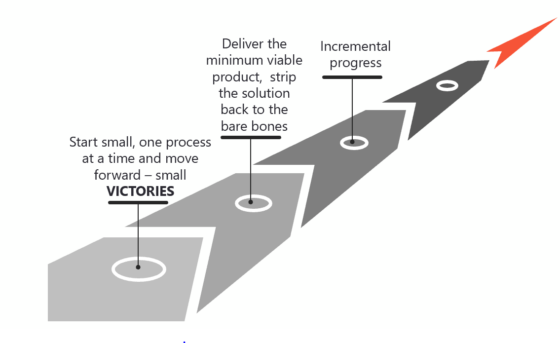KEY DRIVERS OF PROCESSES AND OPERATIONS TRANSFORMATIONS
There is an abundance of reasons for firms to explore maximizing their processes and/or front-to-back operations. Fully understanding the purpose and drivers behind making full or partial changes in these arenas is a key to keeping the project focused and yielding successful results. A firm would do well to build the guiding principles of a project on the key drivers of the changes which could include:
- Reducing operational risk
- Improving operational efficiency by doing more with less
- Improving overall scalability by optimizing the business and technology models
- Refocusing on core business by going back to basics and determining what is done well
- Aligning the right people and/or skills with the jobs at hand
Referring to the drivers keeps transformation projects, especially large-scale ones, focused on foundational goals and on a steady trajectory towards delivering desired results.
SPENDING SMART WHEN OPTIMIZING END-TO-END OPERATIONS
There are many ‘costs’ to consider in managing change. Innovation often comes with a big price tag and can be daunting to understand and then integrate. Firms are operating with leaner budgets and expected to do more with less. Introducing the next big thing can cost political capital and be a multi-year engagement. When investment management firms consider changing their existing operating model, they can find the choices to be overwhelming which can lead to selecting the wrong solution or solving for things that may not be needed. The foundational question is, “What changes will bring the broadest sets of improvements to front-to-back operations?”
The answer to this mission-critical question is spending smart. Spending smart entails identifying the right solutions – the ones that provide value to processes and/or operations in a quantifiable way. It could mean finding ways to do more with what a firm already has, deconstructing how an organization already does things, or focusing on in-house technology and then re-envisioning how it could work better with creative engineering.
For example, when a firm lacks the ability to monitor how tasks and processes move through the organization – a common problem – an economical ‘spending smart’ solution is to consider a workflow tool. There are options available via open source and without cost for an out-of-the box solution. This type of tool can be used to integrate existing technology and automate operational functions. Advantages include the ability to track operational and technical hand-offs between teams through a single platform and to provide oversight, transparency, dashboarding, reporting metrics and intelligence into a process lifecycle. It is also an example of how a firm can leverage their existing technology and ‘spend smart’ in integrating a solution.
INTEGRATING AGILE METHODOLOGY
Transformation projects can be challenging. It takes the right mindset and motivation to make decisions and then move them forward. Often firms spent too much money, are unorganized with execution and experience a series of delays leading firms to question whether they made the right decisions. Employing an Agile approach can alleviate some of the challenges by evolving the project through collaboration and incremental progress. Starting small, transforming one process or component at time, yields small victories.
Using key components of an Agile framework results in projects that have favorable attributes such as:
- Predictable progress with anticipated outcomes
- Costs and scope that are known at the beginning
- Highest value items are prioritized first
- Results demonstrated early and often which maintains momentum
- Phases that welcome change and adaption
A chief differentiator between Agile and other project management methodologies is the strong collaboration between IT and business. In more traditional methodologies such as Waterfall, the business writes lengthy requirements documents and then passes them to IT only to see development later in testing phases when it is too late to make changes in a timely and cost-effective way. Agile teams work together on a solution and show results quickly – focusing on the most important value items first. Additionally, Agile has continuous attention on excellence – move a bite-sized project phase into production and then keep improving it. This results in building a sustainable environment.
Using Agile, whether to improve a process or software, delivers results by building small and releasing changes quickly. Pinpointing tactical approaches allows for quick adjustments and changes.

ALIGNING ‘SPENDING SMART’ AND ‘INTEGRATING AGILE’
On the surface, these concepts may not appear to be aligned. ‘Spending smart’ focuses on examining legacy technology and finding ways to derive value from that framework without starting from scratch. ‘Integrating Agile’ focuses on designing a product that can be delivered quickly and incrementally based on the functionality or processes that a firm uses the most or are the riskiest to an organization. The two concepts are, in fact, closely aligned in that an organization can incorporating change to their existing architecture in rapid and incremental project phases.
Often organizations understand their current limits and inherent risks yet have not spent the time to consider how to improve them. Further, they assume change cannot happen quickly, solving problems requires a large-scale project, a time-consuming waterfall approach – and all at a substantial and undefined cost. Successfully determining what to change and how to affect change efficiently is about:
- Thinking differently when identifying opportunities for big transformations
- Building a smart strategy while incorporating a sustainable focus by continuing to adapt and adjust
- Achieving big progress via little victories – demonstrating progress early during the process creates excitement, engagement and momentum among the teams
- Respecting the budget by not tackling large-scale conversions, delivering results quickly that add value to the organization and contribute to organizational ‘buy-in’

STRATEGY FOR SUCCESSFUL CHANGE
There are strategic steps a firm should take when incorporating the concepts of spending smart and integrating Agile.
- Invest the time to review and determine if and how legacy technology can be leveraged and what value can be derived. Doing a deep dive early can effectively uncover the right solutions.
- Consider how legacy technology can be improved. For example, simply adding a workflow solution can yield desired results.
- Access the value vs. risk and how they relate to operations. Sometimes solutions appear attractive but do not deliver any value.
- Include both tactical and strategic considerations in the roadmap to ensure both quick results and sustainability and sensibility during the long term.
- Align technology and business in developing solutions. These interdependent parties both need to contribute the solution.
- Build a plan on ‘smart’ execution and deployment using Agile methodology.
Connecting the two concepts can bring quick results in reengineering legacy architecture, show early meaningful progress/value, and keep costs predictable and smart.
HOW MERADIA CAN HELP
When it’s important to maximize your firm’s efficiency to stay competitive in a dynamic environment; Meradia can bring a comprehensive toolkit to identify and implement the ‘right’ changes including proven methodologies and skills to:
- Design optimized operating models
- Develop strategies to best leverage existing processes and technology
- Manage Agile programs and projects to implement effective change
 info@meradia.com
info@meradia.com


